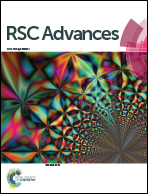Total synthesis of (+)-swainsonine and (+)-8-epi-swainsonine†
Abstract
Enantioselective synthesis of (+)-swainsonine was achieved in 9 steps, with 24% overall yield. The key feature of the synthesis is the tactical combination of reactions: organocatalyzed aldolization/reductive amination, which allows for a rapid construction of highly functionalized heterocyclic systems. In a similar way (+)-8-epi-swainsonine was synthesized (7 steps, 28%).


 Please wait while we load your content...
Please wait while we load your content...